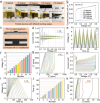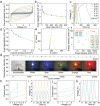Surface Charge Regulation of Graphene by Fluorine and Chlorine Co-Doping for Constructing Ultra-Stable and Large Energy Density Micro-Supercapacitors
- PMID: 39294103
- PMCID: PMC11558090
- DOI: 10.1002/advs.202402033
Surface Charge Regulation of Graphene by Fluorine and Chlorine Co-Doping for Constructing Ultra-Stable and Large Energy Density Micro-Supercapacitors
Abstract
Settling the structure stacking of graphene (G) nanosheets to maintain the high dispersity has been an intense issue to facilitate their practical application in the microelectronics-related devices. Herein, the co-doping of the highest electronegative fluorine (F) and large atomic radius chlorine (Cl) into G via a one-step electrochemical exfoliation protocol is engineered to actualize the ultralong cycling stability for flexible micro-supercapacitors (MSCs). Density functional theoretical calculations unveiled that the F into G can form the "ionic" C─F bond to increase the repulsive force between nanosheets, and the introduction of Cl can enlarge the layer spacing of G as well as increase active sites by accumulating the charge on pore defects. The co-doping of F and Cl generates the strong synergy to achieve high reversible capacitance and sturdy structure stability for G. The as-constructed aqueous gel-based MSC exhibited the superb cycling stability for 500,000 cycles with no capacitance loss and structure stacking. Furthermore, the ionic liquid gel-based MSC demonstrated a high energy density of 113.9 mW h cm-3 under high voltage of up to 3.5 V. The current work enlightens deep insights into the design and scalable preparation of high-performance co-doped G electrode candidate in the field of flexible microelectronics.
Keywords: chlorine; co‐doped graphene; electrochemical exfoliation; flexible supercapacitors; fluorine.
© 2024 The Author(s). Advanced Science published by Wiley‐VCH GmbH.
Conflict of interest statement
The authors declare no conflict of interest.
Figures






Similar articles
-
Electrochemically Exfoliated Chlorine-Doped Graphene for Flexible All-Solid-State Micro-Supercapacitors with High Volumetric Energy Density.Adv Mater. 2022 May;34(19):e2106309. doi: 10.1002/adma.202106309. Epub 2022 Apr 8. Adv Mater. 2022. PMID: 35263463
-
Electrochemically Scalable Production of Fluorine-Modified Graphene for Flexible and High-Energy Ionogel-Based Microsupercapacitors.J Am Chem Soc. 2018 Jul 5;140(26):8198-8205. doi: 10.1021/jacs.8b03235. Epub 2018 Jun 26. J Am Chem Soc. 2018. PMID: 29893575
-
In Situ Grown Ultrafine RuO2 Nanoparticles on GeP5 Nanosheets as the Electrode Material for Flexible Planar Micro-Supercapacitors with High Specific Capacitance and Cyclability.ACS Appl Mater Interfaces. 2021 Oct 13;13(40):47560-47571. doi: 10.1021/acsami.1c12549. Epub 2021 Oct 1. ACS Appl Mater Interfaces. 2021. PMID: 34597012
-
Scalable Fabrication of Photochemically Reduced Graphene-Based Monolithic Micro-Supercapacitors with Superior Energy and Power Densities.ACS Nano. 2017 Apr 25;11(4):4283-4291. doi: 10.1021/acsnano.7b01390. Epub 2017 Mar 31. ACS Nano. 2017. PMID: 28350433
-
Laser-Induced Interdigital Structured Graphene Electrodes Based Flexible Micro-Supercapacitor for Efficient Peak Energy Storage.Molecules. 2022 Jan 5;27(1):329. doi: 10.3390/molecules27010329. Molecules. 2022. PMID: 35011558 Free PMC article.
References
-
- a) Shao Y. Z., Wei L. S., Wu X. Y., Jiang C. M., Yao Y., Peng B., Chen H., Huangfu J. T., Ying Y. B., Zhang C. F. J., Ping J. F., Nat. Commun. 2022, 13, 3223; - PMC - PubMed
- b) Liu H. L., Sun Z. J., Chen Y., Zhang W. J., Chen X., Wong C. P., ACS Nano 2022, 16, 10088; - PubMed
- c) Huang L., Guan T. X., Su H., Zhong Y., Cao F., Zhang Y. Q., Xia X. H., Wang X. L., Bao N. Z., Tu J. P., Angew. Chem., Int. Ed. 2022, 61, e202212151; - PubMed
- d) Yuan Y. J., Jiang L., Li X., Zuo P., Zhang X. Q., Lian Y. L., Ma Y. L., Liang M. S., Zhao Y., Qu L. T., Adv. Mater. 2022, 34, 2110013; - PubMed
- e) He J. Y., Cao L. Q., Cui J. J., Fu G. W., Jiang R. Y., Xu X., Guan C., Adv. Mater. 2023, 36, 2306090; - PubMed
- f) Zhao Q., Wang J. K., Ai X. H., Duan Y. J., Pan Z. H., Xie S. R., Wang J., Gao Y. F., InfoMat 2022, 4, e12298;
- g) Merces L., Ferro L. M. M., Thomas A., Karnaushenko D. D., Luo Y. M., Egunov A. I., Zhang W. L., Bandari V. K., Lee Y. J., McCaskill J. S., Zhu M. S., Schmidt O. G., Karnaushenko D., Adv. Mater. 2024, 36, 2313327. - PubMed
-
- a) Liu D. M., Ma J. X., Zheng S. H., Shao W. L., Zhang T. P., Liu S. Y., Jian X. G., Wu Z. S., Hu F. Y., Energy Environ. Mater. 2022, 0, e12445;
- b) Liu Z. Y., Hu Y. B., Zheng W. H., Wang C., Baaziz W., Richard F., Ersen O., Bonn M., Wang H. I., Ciesielski A. N. A., Müllen K., Samorì P., Adv. Funct. Mater. 2022, 32, 2109543;
- c) Fu M., Chen W., Lei Y., Yu H., Lin Y. X., Terrones M., Adv. Mater. 2023, 35, 2300940. - PubMed
-
- a) Wang T. S., Yu W., Wu D., Zhao W. W., Wang M., Xu J., Zhang J. H., Adv. Funct. Mater. 2023, 33, 2301896;
- b) Ferro L. M. M., Merces L., Tang H. M., Karnaushenko D. D., Karnaushenko D., Schmidt O. G., Zhu M. S., Adv. Mater. Technol. 2023, 8, 2300053;
- c) Li F., Qu J., Li Y., Wang J. H., Zhu M. S., Liu L. X., Ge J., Duan S. K., Li T. M., Bandari V. K., Huang M., Zhu F., Schmidt O. G., Adv. Sci. 2020, 7, 2001561. - PMC - PubMed
-
- Xu Z. Z., Nakamura S., Inoue T., Nishina Y., Kobayashi Y., Carbon 2021, 185, 368.
Grants and funding
LinkOut - more resources
Full Text Sources
